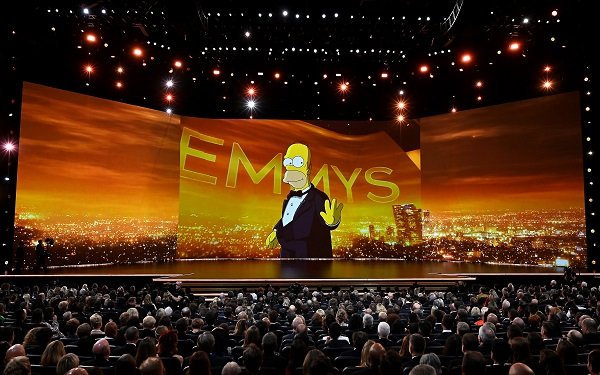Commentary
TV No Longer Has Mass Appeal, And Neither Do Emmys
- by Adam Buckman , Featured Columnist, September 27, 2019

The simple reason why the Emmy ratings are declining every year is because there is no mass-appeal television anymore.
Television today is so fragmented. And one result is that audiences for individual shows -- even the “popular” ones that get all the attention from critics and awards shows -- are so much smaller than what hit shows used to attract in a past era that grows ever more distant.
Last Sunday's "71st Primetime Emmy Awards" telecast on Fox (pictured above) drew an audience of just 6.9 million viewers from 8 p.m. to 11 p.m. Eastern.
That number is down significantly from the audience for the 2018 Emmys on NBC -- a then-record low of 10.17 million. The 2017 Emmys on CBS drew 11.38 million. When journalists described this year’s audience with words such as “plummeting” or “declining sharply,” the words were accurate.
advertisement
advertisement
One TV columnist even wondered whether the Emmys are unsustainable as an annual event on network television. He conjured up a scenario in the near future in which this awards show, which is supposed to be an annual celebration of the greatness of television, would be relegated elsewhere such as TBS or E!.
Moving the Emmys off of broadcast television -- where it rotates among the Big Four (ABC, CBS, Fox and NBC) -- does make sense when one considers the fact that the four networks are hugely underrepresented among the Emmy award winners.
The result has been that network television in recent years has provided this three-hour prime-time showcase in which the best shows on pay-cable and streaming get to strut their stuff and go home with armfuls of awards.
This is not meant as a criticism of the shows that won this year. For the most part, they are quality productions.
However, only one of them garnered what might qualify as a “mass” audience (and even that is debatable) -- HBO's “Game of Thrones,” which won the Best Drama Emmy for the fourth time.
Other big winners that received boatloads of publicity in the post-Emmys press coverage included the Amazon comedy “Fleabag,” BBC America's “Killing Eve,” FX's “Pose,” “The Marvelous Mrs. Maisel” (again) -- also on Amazon -- and others.
But in the aggregate, none of these shows have what anyone would characterize as mass appeal. No one would argue they are not artful, however.
But that's the thing: The TV shows now that attract the lion's share of press, social media and awards attention often feel like the equivalent of what were once known as “art-house movies.” Critics and film buffs loved them, but they were not the same as big-budget movies. The same can be said for the “quality” and “arty” TV shows everyone seems to talk about these days.
On that subject, the TV Blog has offered this opinion before: TV shows produced for commercial-free streaming and those that are produced for an environment characterized by the intrusion of commercials would seem to be very different things.
More to the point: TV series made for non-commercial streaming enjoy all sorts of creative freedoms that are not available generally for commercial-supported productions (although the TV Blog acknowledges that somehow the shows on FX seem to be made like the streaming series, but still attract sponsors).
The point is that audiences for everything that is categorized as “television” today are so much smaller than they once were. It stands to reason that the industry’s annual awards show would seem smaller too.




Adam, there is no doubt that it is virtually impossibe to draw a mass audience for a given episode of a TV show or a one-shot special like the Emmy awards--because the average consumer has so many more channels and streaming options to select from than before. . However that doesn't mean the the medium as a whole no longer has mass appeal as you state in your headline. It does, but viewing has become so fragmented that average minute ratings on the order of 30-35% that were still prevalent in the 1980s--"The Cosby Show"---and much higher in the 1950s and 1960s simply can't be expected anymore. However we should be careful about how we use the current ratings. You state that only 6.9 million people viewed the show. Not so. This is, no doubt, an average comercial minute figure. But how many people zapped the commercials but still watched the show during an average minute? Say that figure is 3-4 million. Then you should add in those who watched portions of the show but not necessarily an average minute-- --its "total audience". That probably adds another 4-6 million. Last but not least there is the digital component of the audience--maybe 1-3 million more. In short, it's entirely possible that 14-18 million people saw the show not 6.9 million.
The actual show was awful in every way, shape and form, kind of like Fux did this on purpose. Their news was not even nominated for a fictional comedy or drama. On the other hand, there are so many choices now that one person or show cannot be the "best" like 1973. The process needs to be adjusted, too.
It would be interesting to trace back to when performers first began using award shows as platforms to promote their social/political ideologies to see if there is a correlation between these actions and general audience decline.
If "award shows" are merely perceived as a front for political grandizing, given the current polaraztion of the country, these drops in viewership should not at all be surprising.